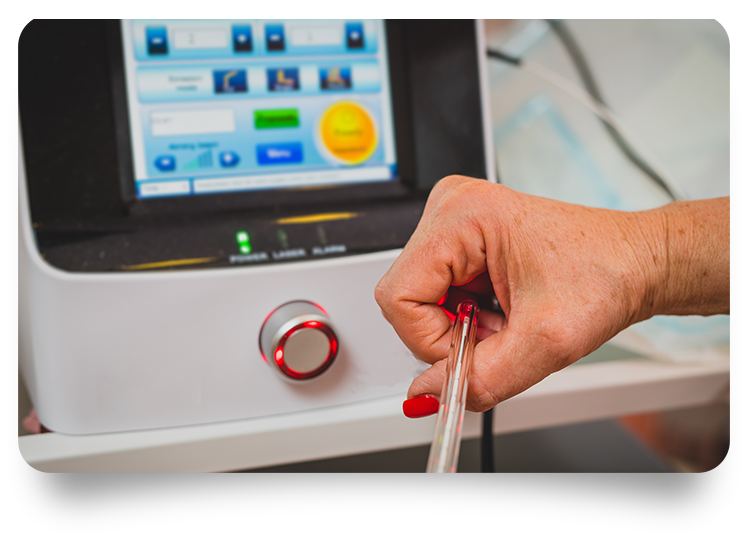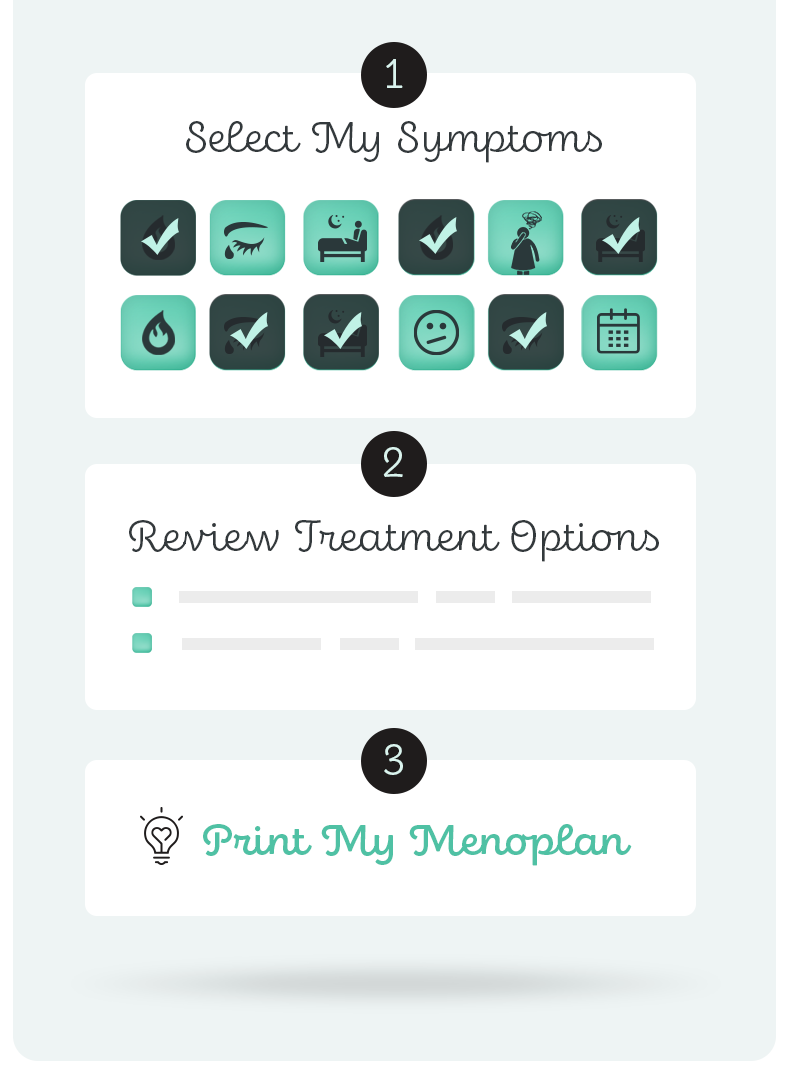Treatments
WHAT IS IT?
With vaginal laser therapy, tiny laser beams make small shallow holes in the vagina via a vaginal probe. Sometimes an external probe is used to treat the opening of the vagina.
The laser most often used is called a fractional laser because it only impacts a fraction of the vagina. There are many types of lasers. The laser used to treat vaginal discomfort is like the laser used by dermatologists to treat facial skin. The theory is that the small holes made by the laser stimulate blood flow, collagen production and tissue healing. It makes the tissue healthier. Depending on the type of laser, the effect reaches 1 mm or less below the surface of the vaginal mucosa.
The current approach in the US is to start with three treatments, about 6 weeks apart. After that there is one treatment a year. sometimes an external probe to treat the opening of the vagina.
OUR BOTTOM LINE: DOES IT HELP?
MAYBE. Laser may work and might be worth trying if:
- you don’t like using a regular medication or product such as a vaginal estrogen or vaginal moisturizer,
- you can afford the out of pocket cost, and
- you are aware that this is still an experimental technology that may or may not work for your specific set of symptoms.

PAIN DURING SEX
Three small randomized trials and other reports suggest that laser treatment may decrease dryness and pain with sex to a similar degree as vaginal estrogen. However, it was less likely than vaginal estrogen to increase the size of vaginal dilator women could comfortably use.
POTENTIAL RISKS & SIDE EFFECTS
Short term side effects include mild to moderate pain with or after the treatment (20% of women), vaginal discharge and spotting (less than 1% of women). These resolve as the vagina heals.
Complications have included burns, scarring, adhesions, and penetration of the vagina by the probe.
The longest current follow-up of women after laser is only 1-2 years. So, we don’t know about long term risks. The rare complications of burns, scarring or serious tissue injury could have a long-term impact on vaginal and sexual health. Some women have reported worsening of symptoms of vaginal or urinary pain and burning.
Laser is NOT an option for women with vaginal mesh (like that used to repair vaginal prolapse). Urethral slings used to treat incontinence are probably fine. Also, it is less ideal for women with a history of genital herpes, as it could provoke an outbreak.
QUALITY OF LIFE EXPECTATIONS
NONE
IF I WANT TO TRY THIS TREATMENT WHAT ARE MY NEXT STEPS?
Find a qualified medical professional providing the service in your area. Have a discussion with them to see if vaginal laser therapy is right for you.
Most of the data available about vaginal laser is from observation and not clinical trials where women are randomized to laser or another therapy and do not know which therapy they are getting. This is not the ideal way to study a new therapy. Thus, what we know about this therapy is incomplete. In three small randomized trials, the effect of the laser seemed comparable to vaginal estrogen, but in two of the studies the estrogen used was much weaker than what is available in the US. This is a promising technology, but there is only a small amount of data to support its benefit, and not much information about its long-term effects.
Athanasiou S, Pitsouni E, Falagas ME, Salvatore S, Grigoriadis T. CO2-laser for the genitourinary syndrome of menopause. How many laser sessions?. Maturitas. 2017;104:24-28. doi:10.1016/j.maturitas.2017.07.007. PMID: 28923173
Cruz VL, Steiner ML, Pompei LM, Strufaldi R, Fonseca FLA, Santiago LHS, Wajsfeld T, Fernandes CE. Randomized, double-blind, placebo-controlled clinical trial for evaluating the efficacy of fractional CO2 laser compared with topical estriol in the treatment of vaginal atrophy in postmenopausal women. Menopause. 2018;25(1):21-28. doi: 10.1097/GME.0000000000000955. PMID: 28763401.
González Isaza P, Jaguszewska K, Cardona JL, Lukaszuk M. Long-term effect of thermoablative fractional CO2 laser treatment as a novel approach to urinary incontinence management in women with genitourinary syndrome of menopause. Int Urogynecol J. 2018;29(2):211-215. doi:10.1007/s00192-017-3352-1. PMID: 28523400
Gordon C, Gonzales S, Krychman ML. Rethinking the techno vagina: a case series of patient complications following vaginal laser treatment for atrophy. Menopause. 2019 Apr;26(4):423-427. doi: 10.1097/GME.0000000000001293. PMID: 30640806
Lanzafame RJ, de la Torre S, Leibaschoff GH. The Rationale for Photobiomodulation Therapy of Vaginal Tissue for Treatment of Genitourinary Syndrome of Menopause: An Analysis of Its Mechanism of Action, and Current Clinical Outcomes. Photobiomodul Photomed Laser Surg. 2019;37(7):395-407. doi:10.1089/photob.2019.4618. PMID: PMID: 31210575
Pagano I, Gieri S, Nocera F, et al. Evaluation of the CO2 Laser Therapy on Vulvo-Vaginal Atrophy (VVA) in Oncological Patients: Preliminary Results. J Cancer Ther 2017;8:452-63.
Paraiso MFR, Ferrando CA, Sokol ER, Rardin CR, Matthews CA, Karram MM, Iglesia CB. A randomized clinical trial comparing vaginal laser therapy to vaginal estrogen therapy in women with genitourinary syndrome of menopause: The VeLVET Trial. Menopause. 2020;27(1):50-56. doi:10.1097/GME.0000000000001416. PMID: 31574047
Perino A, Calligaro A, Forlani F, Tiberio C, Cucinella G, Svelato A, Saitta S, Calagna G. Vulvo-vaginal atrophy: a new treatment modality using thermo-ablative fractional CO2 laser. Maturitas. 2015;80(3):296-301. doi:10.1016/j.maturitas.2014.12.006. PMID: 25596815
Pieralli A, Bianchi C, Longinotti M, Corioni S, Auzzi N, Becorpi A, Fallani MG, Cariti G, Petraglia F. Long-term reliability of fractioned CO2 laser as a treatment for vulvovaginal atrophy (VVA) symptoms. Arch Gynecol Obstet. 2017;296(5):973-978. doi:10.1007/s00404-017-4504-8. PMID: 28866727
Pitsouni E, Grigoriadis T, Tsiveleka A, Zacharakis D, Salvatore S, Athanasiou S. Microablative fractional CO2-laser therapy and the genitourinary syndrome of menopause: An observational study. Maturitas. 2016;94:131-136. doi:10.1016/j.maturitas.2016.09.012. PMID: 27823733
Politano CA, Costa-Paiva L, Aguiar LB, Machado HC, Baccaro LF. Fractional CO2 laser versus promestriene and lubricant in genitourinary syndrome of menopause: a randomized clinical trial. Menopause. 2019;26(8):833-840. doi:10.1097/GME.0000000000001333. PMID: 31246661
Salvatore S, Nappi RE, Parma M, Chionna R, Lagona F, Zerbinati N, Ferrero S, Origoni M, Candiani M, Maggiore ULR. Sexual function after fractional microablative CO(2) laser in women with vulvovaginal atrophy. Climacteric. 2015;18(2):219-225. doi:10.3109/13697137.2014.975197. PMID: 25333211
Samuels JB, Garcia MA. Treatment to External Labia and Vaginal Canal With CO2 Laser for Symptoms of Vulvovaginal Atrophy in Postmenopausal Women. Aesthet Surg J. 2019;39(1):83-93. doi:10.1093/asj/sjy087. PMID: 29726916
Sokol ER, Karram MM. An assessment of the safety and efficacy of a fractional CO2 laser system for the treatment of vulvovaginal atrophy. Menopause. 2016;23(10):1102-1107. doi:10.1097/GME.0000000000000700. PMID: 27404032
Sokol ER, Karram MM. Use of a novel fractional CO2 laser for the treatment of genitourinary syndrome of menopause: 1-year outcomes. Menopause. 2017;24(7):810-814. doi:10.1097/GME.0000000000000839. PMID: 28169913
Authors: Dr. Susan Reed, Dr. Katherine Newton, & Dr. Leslie Snyder. Last reviewed April, 2021



